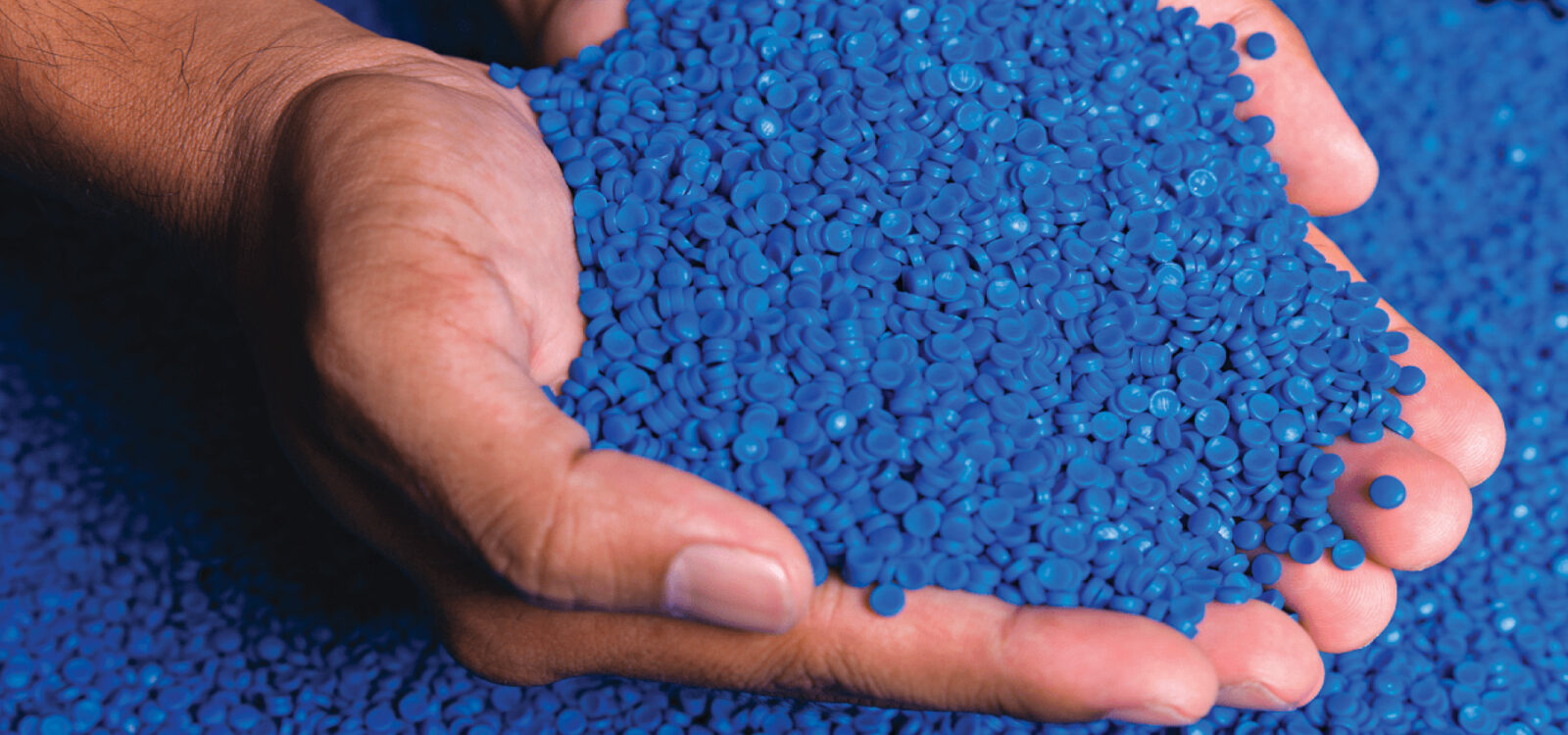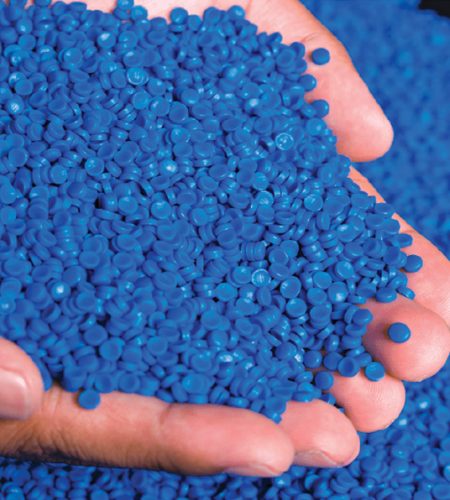
Polymers

.
Polymers are giant molecules made up of many smaller, repeating units called monomers.
It’s easier to ask where plastics AREN’T used! Polymers are in virtually every aspect of modern life:
What is HDPE?
- A Type of Plastic: One of the most common plastics in the world, belonging to the polyethylene family.
- Structure: Made up of long chains of ethylene monomers (derived from petroleum), with minimal branching in its structure. This leads to its higher density and rigidity compared to other types of polyethylene.
Key Properties of HDPE
- High Density: More tightly packed molecules make it denser and stronger than LDPE (low-density polyethylene).
- Rigidity and Strength: Not easily flexible, can withstand significant force and resist breakage.
- Chemical Resistance: Stands up to many common chemicals, solvents, acids, and bases.
- Weather Resistant: Durable under sun exposure and variable temperatures.
- Moisture Barrier: Excellent at keeping moisture out.
- Recyclable: HDPE carries the #2 recycling symbol.
Common Uses of HDPE
HDPE’s properties make it suitable for a massive range of applications:
- Packaging:
- Milk jugs & Bottles: Its rigidity and moisture barrier protect liquids.
- Detergent and Chemical Containers: Resistant to the chemicals within.
- Food Containers: Provides a safe and sturdy storage option.
- Construction:
- Piping: Strong, durable, and corrosion-resistant, perfect for plumbing and water transport.
- Lumber: HDPE “plastic lumber” offers an alternative for outdoor constructions like decks and benches.
- Transportation:
- Fuel Tanks: Durable and non-corrosive, ideal for vehicles.
- Pallets: Able to withstand heavy loads and harsh conditions.
- Consumer Goods
- Toys: Its toughness makes it resistant to breakage.
- Cutting Boards: Hygienic and easy to clean.
- Outdoor Furniture: Withstands weathering and wear-and-tear.
Why is HDPE so Popular?
- Combination of Properties: Strong, durable, lightweight, and resistant to many factors.
- Cost-effective: Relatively inexpensive to produce and process.
- Versatility: Can be molded into countless shapes and used in numerous applications.
- Recyclability: While complex, HDPE recycling infrastructure is established in many areas.
What is LDPE?
- A Versatile Plastic: A member of the polyethylene family, a major and common type of plastic derived from petroleum sources.
- Structure: Made from ethylene monomers, but its structure has extensive branching, unlike the more linear structure of HDPE. This branching results in lower density and greater flexibility.
Key Properties of LDPE
- Lower Density: Less tightly packed molecules, making it lighter than HDPE.
- Flexible: Bends and deforms easily.
- Transparent: Often clear or translucent in its basic form.
- Chemical Resistance: Resists many common chemicals.
- Good Moisture Barrier: Protects items from moisture.
- Recyclable: Recyclable with the #4 recycling symbol.
Common Uses of LDPE
Due to its properties, LDPE finds its way into numerous everyday items:
Packaging
- Plastic Bags: Grocery bags, trash bags, sandwich bags rely on flexibility and toughness.
- Films: Shrink wrap, cling wrap, protective packaging.
- Squeezable bottles: For sauces, liquids where dispensing is key.
Agriculture
- Greenhouse/Mulch Films: Traps heat and moisture and can suppress weeds.
Other Applications
- Coatings: On paper cups/cartons for waterproofing.
- Wire and cable insulation: Protects electrical components.
- Toys and flexible containers: Takes advantage of its squeezable nature.
LDPE vs. HDPE
- Density: LDPE is lower in density than HDPE, making it lighter and less rigid.
- Flexibility: LDPE is more flexible, while HDPE tends to be stronger and more rigid.
- Transparency: LDPE tends to be more translucent, where HDPE can be more opaque.
Why is LDPE Popular?
- Flexibility and Softness: Ideal for applications where bendability is a priority.
- Cost-Effective: Generally cheaper to produce than HDPE.
- Ease of Processing: Can be easily formed into various shapes and films.
What is LLDPE?
- Linear Low-Density Polyethylene: LLDPE is a type of polyethylene (a very common plastic) characterized by its mostly linear structure with short-chain branches. This gives it unique properties compared to other types of polyethylene.
How is it Made?
- Copolymerization: LLDPE is made by copolymerizing ethylene (the primary building block) with longer-chain olefins (alpha-olefins) like butene, hexene, or octene. This happens at lower temperatures and pressures than other polyethylene types.
- Catalysts: The process is usually aided by transition metal catalysts, most commonly Ziegler-Natta or Phillips-type catalysts.
Properties of LLDPE
- High Tensile Strength: LLDPE can withstand greater forces before breaking compared to LDPE.
- Impact and Puncture Resistance: It offers superior resistance to damage from sharp objects or sudden forces.
- Flexibility: LLDPE is able to stretch and elongate quite a bit under stress, making it useful for applications requiring that type of deformation.
- Environmental Stress Crack Resistance: LLDPE handles exposure to chemicals and environmental stressors better than some other plastics.
Common Uses of LLDPE
Because of its properties, LLDPE is widely used for:
- Films: Packaging films, stretch wrap, agricultural films, trash bags
- Containers and Bottles: Flexible packaging materials and squeezable bottles.
- Pipes and Tubing: Due to its durability and chemical resistance.
- Wire and Cable Coatings: Its good electrical properties make it suitable for this application.
- Toys and Other Products: You’ll find LLDPE in many everyday items due to its strength and flexibility.
What is Polypropylene (PP)?
Polypropylene (PP), also known as polypropene, is a versatile thermoplastic polymer. It’s made from the monomer propylene and belongs to the polyolefin group of plastics.
Key Properties
- Semi-crystalline: PP exists in a partially structured (crystalline) form, contributing to its strength and chemical resistance.
- Lightweight: It’s one of the lightest commercial plastics.
- Chemical Resistance: It resists many solvents, acids, and bases.
- Good Heat Resistance: It has a relatively high melting point, making it suitable for applications where heat is a factor.
- Tough and Flexible: PP can withstand bending and deformation without breaking.
- Good Electrical Insulator
How It’s Made
Polypropylene is created through chain-growth polymerization of propylene monomers. This process usually uses specific catalysts, like Ziegler-Natta catalysts.
Common Uses of Polypropylene (PP)
PP is everywhere! Here are some primary areas where it’s used:
- Packaging: Food containers, films, bottles due to its resistance and sealability
- Automotive: Bumpers, battery cases, interior parts due to its toughness and weight advantages.
- Textiles: Non-woven fabrics (tote bags, medical gowns), carpet fibers, ropes because of its strength and moisture resistance.
- Medical: Medical equipment, syringes, labware due to its chemical resistance and ability to be sterilized.
- Consumer Goods: Toys, appliances, and various other household products.
What is Polyurethane (PU)?
Polyurethanes (PU) are a remarkably versatile class of polymers formed by reacting polyols (compounds with multiple hydroxyl groups) with diisocyanates or polymeric isocyanates. The variety of polyols and isocyanates available makes it possible to create polyurethanes in a huge range of forms with differing properties.
Key Properties of Polyurethane
Polyurethanes can be tailored to be soft and flexible, or rigid and strong, depending on the specific components used in their creation. Some common properties include:
- Durability: Resistance to abrasion, wear, and tear.
- Flexibility: The ability to bend and stretch without breaking. This is prominent in flexible foams.
- High Tensile Strength: Rigid types can withstand significant load before breaking.
- Chemical Resistance: They generally resist solvents, acids, and bases.
- Thermal Insulation: Especially PU foams.
Common Forms of Polyurethane
- Flexible Foams: Comfort materials in furniture, bedding, and automotive seats.
- Rigid Foams: Excellent insulation in construction, appliances, and other products..
- Coatings, Adhesives, Sealants, and Elastomers (CASE): Found in paints, adhesives for diverse applications, sealants for protection, and durable elastomers used in many industrial components.
- Fibers: Used in spandex and similar stretchy fabrics.
How it’s Made
The key reaction in making polyurethane is the addition between an isocyanate group (-N=C=O) and a hydroxyl group (-OH), forming the characteristic urethane linkage.
What is Polystyrene (PS)?
Polystyrene (PS) is a synthetic polymer composed of styrene, a liquid hydrocarbon building block. It is lightweight, rigid, and inexpensive, making it one of the most common plastics globally. It can exist in both solid and foamed forms.
Types of Polystyrene
- General Purpose Polystyrene (GPPS): Clear, hard, and brittle. Ideal for applications where low cost and transparency are important.
- Expanded Polystyrene (EPS): Familiar under the trade name Styrofoam™, this is the lightweight, white foam with excellent insulation properties.
- High Impact Polystyrene (HIPS): Enhanced with rubber to increase impact resistance and toughness.
Key Properties of Polystyrene
- Transparency (GPPS): Solid polystyrene lets light through with little distortion.
- Rigidity: It’s stiff and maintains its shape well.
- Good Electrical Insulator: Makes it helpful for electronics applications
- Cost-effective: It’s inexpensive to produce.
- Recyclable
Common Applications of Polystyrene
- Packaging: Disposable food containers, clamshells, packing peanuts (mainly EPS).
- Construction: Thermal insulation (EPS), foam building panels.
- Consumer Goods: CD cases, toys, appliance housing.
- Medical: Petri dishes, test tubes, labware due to its clarity and ability to be sterilized.
What is PET?
PET stands for polyethylene terephthalate. It’s a type of clear, strong, and lightweight plastic that belongs to the polyester family. PET is a common choice for many products, particularly food and beverage packaging.
How is PET Made?
PET is manufactured through a polymerization process involving two monomers: ethylene glycol and terephthalic acid (or its derivative dimethyl terephthalate). These react to create long chains of the PET polymer.
Key Properties of PET
- Clarity: PET offers excellent transparency, making it perfect for showcasing products.
- Strength & Impact Resistance: It can withstand everyday handling and transportation without easily breaking.
- Barrier Properties: It provides a good barrier against gases like oxygen and carbon dioxide, helping preserve freshness.
- Chemical Resistance: It resists many common chemicals.
- Recyclability: PET is one of the most widely recycled plastics.
Common Applications of PET
- Beverage Bottles: Soda bottles, water bottles, juice bottles are largely made with PET.
- Food Packaging: Containers, jars, trays due to its clarity and food-safe qualities.
- Textiles: Used to make PET fibers (known as polyester) for clothing, carpets, and more.
- Other Applications: Films, engineering components, and various household products.
Environmental Considerations
While PET is highly recyclable, proper waste management is crucial for minimizing its environmental impact. Recycled PET (rPET) can be used to produce new products, reducing the need for virgin plastic.
What are Acrylics?
Acrylics refer to a family of synthetic polymers derived from acrylic acid or acrylates. They are broadly known for their transparency, strength, and weather resistance. Acrylics come in several forms, each with its own characteristics and applications:
Key Types of Acrylics
Poly(methyl methacrylate) (PMMA): Often referred to as acrylic glass or Plexiglas®. PMMA is a rigid, transparent thermoplastic with outstanding visual clarity. It’s used for:
- Windows and aircraft canopies
- Signage and displays
- Optical lenses and lighting fixtures
- Aquarium tanks
Acrylic Resins: Liquid acrylic polymers used to create various materials:
- Acrylic Paint: Fast-drying, water-soluble paints valued for their vivid colors and ability to mimic watercolor or oil paintings. Used extensively in art and crafts.
- Acrylic Coatings: Protective and decorative coatings for a variety of surfaces like wood, metal, and concrete.
- Acrylic Adhesives: Strong bonding agents for industrial and construction applications.
- Acrylic Paint: Fast-drying, water-soluble paints valued for their vivid colors and ability to mimic watercolor or oil paintings. Used extensively in art and crafts.
Acrylic Fibers: These create soft, resilient yarns used in textiles like sweaters, carpets, blankets, and upholstery.
Key Properties of Acrylics
- Transparency: Especially relevant for PMMA, which rivals glass in clarity.
- Durability: Resistance to impact, shattering, and weathering.
- Formability: PMMA can be molded into complex shapes.
- Colorability: Acrylic paints offer a wide range of colors.
- UV Stability: Resistance to yellowing and degradation by sunlight.

Why Choose BLACKSEA TRADING COMPANY?
Quality Assurance: We ensure the highest quality standards for all our products, delivering reliability and excellence.
Competitive Pricing: Our commitment to fair and reasonable pricing ensures you get the best value for your investment.
Reliable Supply: Count on us for consistent and timely deliveries, maintaining seamless operations for your business.
Exceptional Service: Our team is dedicated to providing outstanding service, addressing your inquiries promptly and effectively.
Take this opportunity to optimize your sourcing strategy and benefit from our premium offerings. Please reach out to us at info@black-sea.com.tr to discuss your specific requirements or to placean order. We’re here to assist you in every step of the process.
We look forward to continuing our successful collaboration.
PRODUCT ENQUIRY FORM

Blacksea is an independent energy trading company specializing in the global supply and distribution of petroleum and refined fuels. Committed to sustainability, risk management, and logistical excellence, we connect producers and end-users across key markets. Our focus on integrity and efficiency drives long-term value for our partners in the ever-evolving energy landscape.
With a keen focus on excellence and innovation, we offer comprehensive consultancy services tailored to meet the diverse needs of our clients.
Soft Commodity
Petrochemicals
Independent Energy Trading
- Home
- Company
- Commodity
- Contact
- Incoterms – ICC
- +90 541 232 9346Call Us Now!
- info@black-sea.com.trTalk To Us
MagmaReactive – ✨ Creativity unleashed.